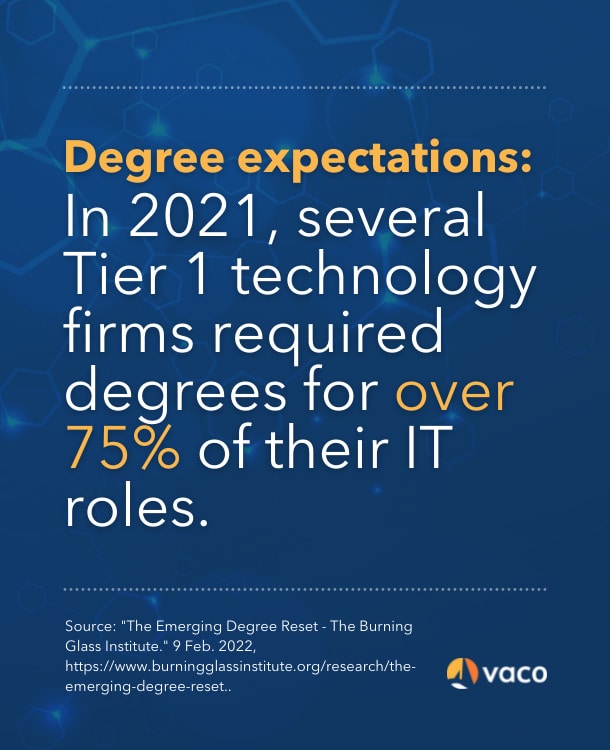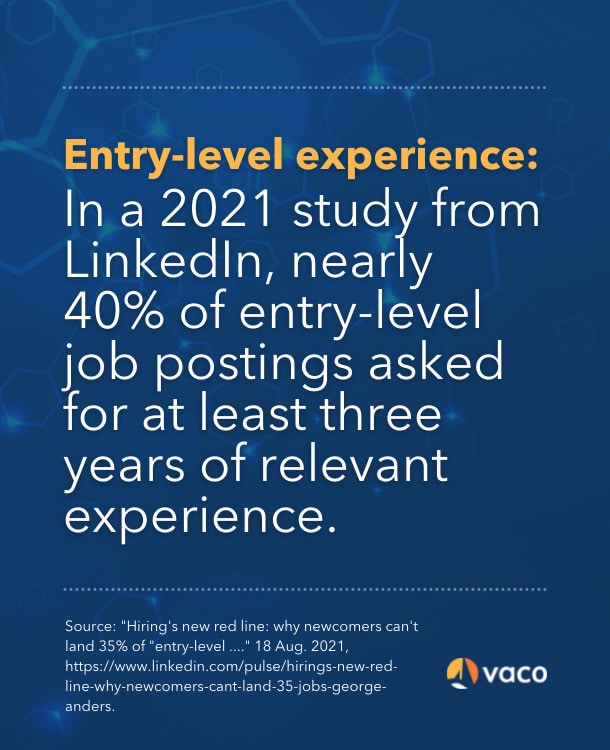In the first and second articles in this series, we looked at how the shrinking labor force and the changing expectations of employees have contributed to companies’ current hiring struggles. For our third and final installment, we’re examining the gap between the unprecedented demand for certain skills and qualifications—and the strained supply of candidates who meet the criteria.
Before COVID-19 arrived, numerous occupations were projected to grow dramatically over the coming years. In many cases, the pandemic only accelerated that demand. At the same time, the skills required for many existing jobs expanded, primarily to reflect the growing necessity of technical knowledge and digital fluency in the modern workforce.
Unfortunately, the pandemic also created an environment where the pursuit of skill-building, high-level certifications, and college degrees was delayed—or even abandoned—by millions of workers. Salaries have soared for professionals with hard-to-find skills, and traditional avenues for sourcing skilled candidates seem broken.
The results have been frustrating for employers, to say the least. As job openings that require or prefer certain skill sets have multiplied by the thousands, the supply of qualified candidates appears to have flat-lined.
The pandemic exacerbated a years-long shortage of in-demand skills
To illustrate how the pandemic strained companies’ existing skills gaps, let’s look at tech skills in particular.
The societal, behavioral, and economic changes brought by the pandemic accelerated an already-booming demand for tech talent in the global workforce. Remote work, telehealth, ecommerce, and automation surged across virtually every industry. These trends created an urgent need for skills in software development, data science, cybersecurity, AI, and cloud computing, just to name a few.
The results of this exploding demand? A worldwide shortage of qualified workers to fill these roles. Take software developers, for instance. The IDC Market Perspective projects that there will be a global shortage of four million skilled developers by 2025. In the United States alone, the number of job openings for developers is projected to grow by 22% by 2030.
Our authors

Rusty Williams, Senior Director, Technology Solutions

Mike Christoferson, Senior Director of Sales, Technology Solutions
Digital skills are also in demand for roles that aren’t tech-centric. As companies have adopted new technology and digital processes, a growing number of roles require medium-level or high-level digital fluency. Accountant roles, for example, now regularly require Advanced Excel usage, working knowledge of business management software, and the ability to utilize systems that feature automation or artificial intelligence.
By some estimates, around 80% of middle-skill jobs in the United States require some array of digital skills.
Recruiting and hiring strategies often screen out qualified candidates
Even as competition explodes for candidates with particular skill sets, many organizations’ hiring processes and job requirements remain staunchly exclusive. For example, many hiring companies immediately screen out candidates with relevant experience because they don’t have a college degree, even when a degree isn’t necessary to do the job.

This phenomenon, known as degree inflation, has limited the job opportunities of millions of American workers and is especially detrimental to members of historically underserved populations and protected groups. It also eliminates qualified candidates who are skilled through alternative routes (STARs).
While there has been a push in recent years to roll back degree requirements, some industries continue to pursue a very specific type of job candidate.
One multi-year study published in 2022 examined degree requirements for tech and IT jobs at the world’s largest technology firms over the previous four years. While some large tech firms rolled back degree requirements during that time span, others expanded them. In fact, a handful of them specified degree requirements in over 75% of their IT job listings as recently as 2021.
Similarly, arbitrary requirements for years of experience deter candidates who have excellent skills but don’t meet the experience threshold. One multi-year study from LinkedIn found that nearly 40% of jobs listed as entry-level asked for a minimum of three years of relevant work experience. Within the software and IT services industry, that percentage rose to 60.3%.
How can companies address the shortage of qualified candidates?

Companies are likely to face hiring challenges for the foreseeable future, especially if they’re recruiting for in-demand roles. But there are strategies to help bolster recruiting efforts and locate incredible candidates you may have otherwise overlooked.
One strategy is to prioritize candidates’ skills and competencies—rather than academic pedigree or industry-specific experience—when evaluating job applicants. Skills-based hiring can help companies expand their talent pools and discover great candidates who were previously screened out or discouraged from applying because they lacked four-year degrees or extensive experience.
Similarly, companies that offer no flexible work arrangements are missing out on millions of candidates who prioritize remote, hybrid, and schedule flexibility in their job searches. By opening roles to remote and hybrid job seekers, companies can see an uptick in applicants and host a more diverse and skilled range of candidates when it’s time to interview.
Here are some additional strategies for coping with a lack of qualified candidates in your talent pipeline:
- Focus on upskilling and reskilling your existing team members to close skills gaps: Many companies are contending with ever-widening skills gaps on their teams in the post-COVID world. Digital skills, technical skills, and soft skills—communication, decision-making and leadership, for example—are in particular shortage as companies adapt to the post-COVID world. Upskilling and reskilling your current team members can fill the gaps in your organization and improve retention for top performers by providing opportunities to advance and diversify their skill sets.
- Be open to consultants, contract-to-hire, and temporary workers: Consultants and contract workers can help keep crucial work on track while you search for qualified long-term employees.
- Change your recruiting process: In a job market with so few active candidates, companies may need to expand and pivot in their recruiting efforts. By partnering with a recruiting firm, you can gain access to passive candidates and an expanded network of job seekers who may never find you otherwise.
Check out the other articles in this series to get even more insights on the current talent shortage:
The hiring and recruiting experts at Vaco help companies of all sizes find top talent for a variety of roles, whether they’re remote, hybrid, or on-site. Learn more about our expertise or reach out to our talent specialists to see how we can transform your hiring efforts.
If you’re a candidate searching for your next dream job, Vaco is here to be your partner and career advisor throughout your professional life. Explore our job seeker resources for interview tips, advice on writing your resume, and downloadable resume templates to help you put your best foot forward in your job search. If you’re ready to work with an experienced career expert during your job search, reach out to us today.
